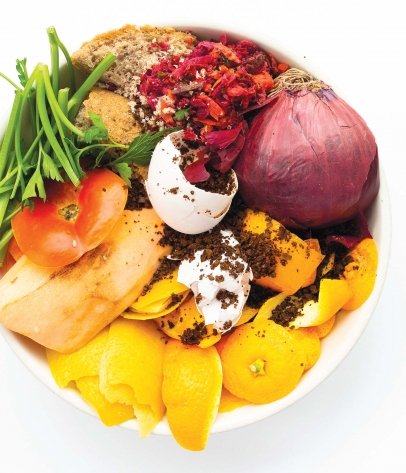12 Tips to Reduce Waste in the Home Kitchen
There are so many suggestions for preventing food and plastic waste peppered throughout this issue. Here are 12 more—these are the ones we use most in our home kitchen.
BONUS BAGS // If you’re still buying cereal in boxes, what do you do with that plastic liner bag? You can use it to pound out chicken breasts or smash stale bread into crumbs; they’re more durable than a ziptop. Wash and reuse as many times as possible.
EAT YOUR MEAT // Beef, pork, lamb, duck, chicken, turkey: These leftovers get new life shredded into a Bolognese-style ragù to toss with pasta.
NO-BRAINERS // Make crumbs and croutons from old bread. Fry chips from stale tortillas. Make jam from softening fruits. Purée soups out of wilty vegetables and season them with hard cheese rinds. Use soured milk in your pancakes in place of buttermilk. Easy peasy.
WASH ’EM IF YOU’VE GOT ’EM // Make a pledge that the plastic storage bags you currently own will be the last ones you buy, then wash after use and hang to dry. Kick your disposables habit with a collection of cloth napkins from a thrift store or flea market; embroider initials for every family member so you know whose is whose.
COLLECT THEM ALL // Keep a designated “Stock Bank” bag in the freezer to collect scraps of vegetables and meat bones; when it’s full, make a pot of broth. If you don’t need it right away, freeze that, too. You’ll never buy a box of stock again. Why throw away a poultry carcass when homemade stock is so easy?
JUST USE IT // Use your herb stems, carrot tops, kale ribs, broccoli stalks and celery hearts in smoothies and soups; they have a ton of flavor and nutrition and are better inside your body than in the trash. Deep fry potato and carrot peels; make broth from ginger trimmings; candy your citrus rinds.
GROW YOUR OWN // Want to create a tiny kitchen garden during the coldest months? Arrange the end trimmings of scallions, with roots attached, inside a short glass and fill halfway with water. New scallions will emerge from the core. Try this with leeks, celery, romaine lettuce— anything with a stem end will re-grow with a few days in water. Trim the new growth and use in salads or as a garnish—kids love watching the daily progress.
WILL IT FRITTER? // Anything can be made into a fritter: Clean out the crisper drawer and shred every root vegetable in it. Add some minced onion, an egg or two and some seasoned flour. Fry in patties and serve with lemon or sour cream.
WILL IT TACO? WILL IT DUMPLING? // Likewise, anything can be made into a taco. Shred leftover meat and simmer with chilies, tomatoes, garlic and spices. Fold into charred tortillas and top with scallion trimmings and minced cilantro stems. Or make dumplings: Combine minced leftover meat with scallions, tamari, ginger and garlic; seal inside wonton skins and steam or pan-fry.
RICE IS NICE // Leftover rice is like money in the bank. Make fried rice with forgotten vegetables. Mix with shredded meat and roll into cabbage bundles. Make rice pudding with coconut milk and honey. Blend with water, sugar and cinnamon; strain over ice for the freshest horchata.
STOP BEFORE YOU SHOP // Make “Sweep the Kitchen Twice” into a regular thing. Go shopping in your fridge before heading out to the supermarket. You’ll be surprised by what can be re-used and repurposed, and how thinking this way will save you both money and time.
YOUR NOSE KNOWS // The most important tip of all: Use printed “expiration” or “best by” dates as a suggestion, not a rule. Be cautious, of course—if something smells bad, it’s bad. If it still smells good, taste it! Compost what you can’t reuse and get rid of food that’s really, truly gone bad.





